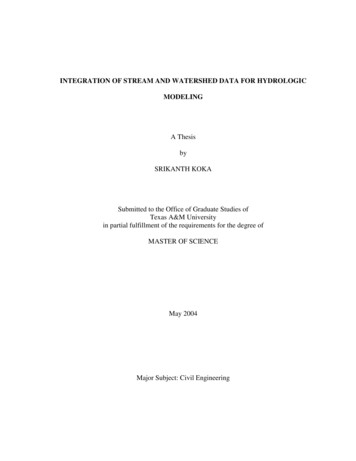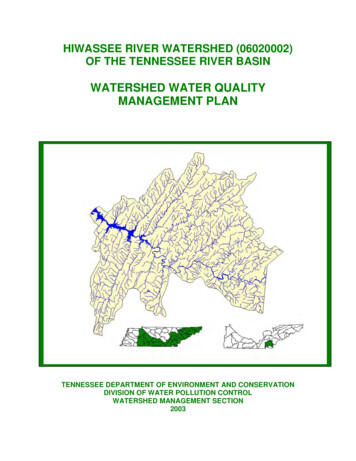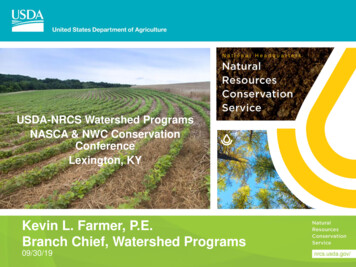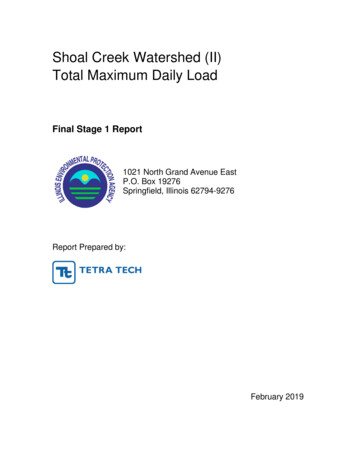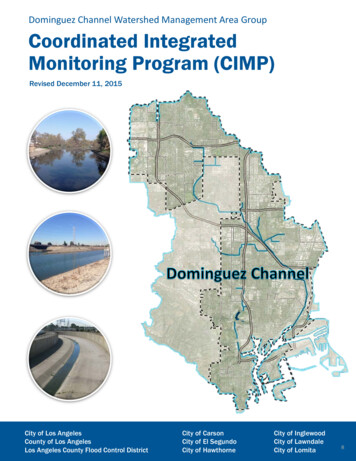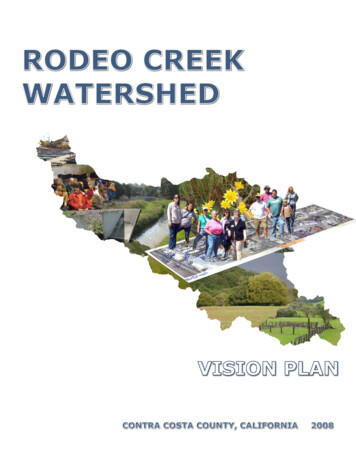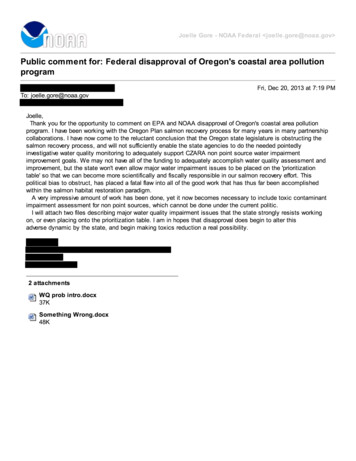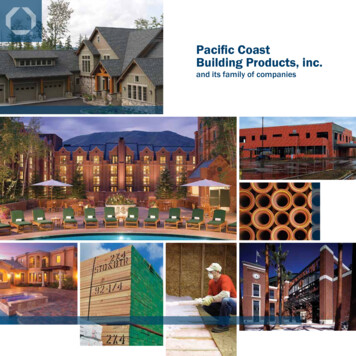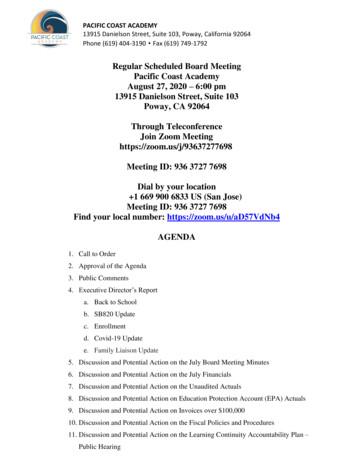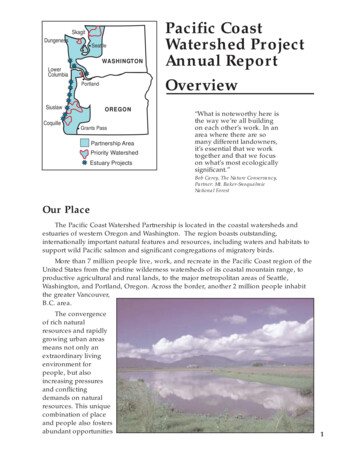
Transcription
iewPortlandSiuslawCoquillePacific CoastWatershed ProjectAnnual ReportOREGONGrants PassPartnership AreaPriority WatershedEstuary Projects“What is noteworthy here isthe way we’re all buildingon each other’s work. In anarea where there are somany different landowners,it’s essential that we worktogether and that we focuson what’s most ecologicallysignificant.”Bob Carey, The Nature Conservancy,Partner: Mt. Baker-SnoqualmieNational ForestOur PlaceThe Pacific Coast Watershed Partnership is located in the coastal watersheds andestuaries of western Oregon and Washington. The region boasts outstanding,internationally important natural features and resources, including waters and habitats tosupport wild Pacific salmon and significant congregations of migratory birds.More than 7 million people live, work, and recreate in the Pacific Coast region of theUnited States from the pristine wilderness watersheds of its coastal mountain range, toproductive agricultural and rural lands, to the major metropolitan areas of Seattle,Washington, and Portland, Oregon. Across the border, another 2 million people inhabitthe greater Vancouver,B.C. area.The convergenceof rich naturalresources and rapidlygrowing urban areasmeans not only anextraordinary livingenvironment forpeople, but alsoincreasing pressuresand conflictingdemands on naturalresources. This uniquecombination of placeand people also fostersabundant opportunities1
for developing partnerships to conserve, restore, and enhance our water quality andaquatic and estuarine habitats.The Pacific Coast Watershed Partnership was formed to save wild salmon andthe international flyway of migratory birds. We are linking key estuaries, wetlands, anduplands to restore the habitat necessary for the survival of these special resources.Our restoration efforts are designed to recover and protect salmon and other aquaticspecies, migratory birds, and water quality to contribute to the livable environment thathas been the hallmark of the Pacific Northwest. More than 40 federal, state, and privatepartners are working together across five watersheds to tackle the complex challengesfacing our dynamic and invaluable coastal ecosystems.Our Vision Healthy and diverse salmon populations premier fishing opportunities. Rivers run clear and cold and support people and wildlife. We live in balance with ecosystem potential. Livability ranking is the highest in the nation. We are a highly sought ecotourism destination. Waterfowl and wildlife abound.The IssuesBalancing social, economic, and environmental needs will be the key to restoration andprotection of habitats for salmon, waterfowl, and other wildlife in this region.Wild Salmon and TroutWild Pacific salmon and trout have disappeared from some 40 percent of the PacificNorthwest rivers in which they historically spawned. Salmon populations in 44 percent ofthe remaining streams are at risk; 26 distinct populations of Pacific salmon and steelheadare now listed as threatened or endangered under the Endangered Species Act. Manyfactors have contributed to salmon decline, including dams, hatcheries, habitat loss, andwater diversions.Migratory WaterfowlThe diverse wetlands of the Oregon and Washington coast support more than 30species of waterfowl. Hundreds of thousands of ducks, geese, scoters, swans, cranes,loons, shorebirds, and neotropical migratory birds use the tidal marshes, estuaries, andother coastal habitats, mostly during migration or in winter. Human population growthand development have significantly affected wetland and estuarine habitats; in Oregonalone, 50 to 80 percent of intertidal marsh habitats have been diked for farmlandconversion. Overall along the Pacific Coast in Oregon and Washington, wetlands havebeen reduced by 30 percent.2
illeOREGONGrants PassPartnership AreaPriority WatershedEstuary ProjectsProjects in the Pacific Coast Watershed Partnershipare intended to achieve: Restoration: Restore water quality and aquatic habitat across whole watersheds inboth the long and short terms. The focus is on threatened and endangered speciesof salmon and trout, and on waterfowl. Assessment: Use watershed analysis or other rigorous assessment processes toaddress environmental conditions that limit attainment of the restoration goalsidentified by local groups. Prioritization: Focus restoration practice in high priority areas, using the best scienceand yielding the highest return for investment dollars. Partnership: Show integration of restoration projects across ownership boundaries.Build or sustain partner commitment. Resource Improvement: Facilitate or contribute to significant improvement ofresource conditions, enough to show a perceptible positive change through aneffectiveness monitoring plan. Education: Enhance agency personnel or resident understanding of watershed andaquatic ecological processes.Our StrategyFocus on the critical few.We aim to group watersheds with thehighest potential for recovery into arefuge system to restore habitateffectively. Our efforts are designed torestore estuarine habitat to protectimportant life phases of salmon andmigratory waterfowl.3
Our Strengths Focus action on critical areas. Promote sustainable community land use. Protect and restore natural processes. Support collaborative processes. Focus on relationships, shared problem recognition, and joint problem solving. Leverage funds to accomplish more than any single entity can.“Partnerships can help accomplish work, but partnering is as much about buildingrelationships as it is about outcomes. Working in partnership is a way of thinking andengaging with others. It is a way of building trust and facilitating the process of jointproblem-solving.”-- excerpted from Beyond Boundaries: Resource Stewardship on the Skagit River, produced by the Mt. Baker-SnoqualmieNational Forest, PCWP partner, October 2000Pacific Coast Watershed Partnership“When we see land as acommunity to which webelong, we may beginto use it with love andrespect.”Aldo LeopoldPartnersThe following are the major partners who make up the Pacific Coast WatershedPartnership. Each of these has its own extensive network of partners, creating apartnership network of extraordinary depth and breadth, working in various ways toachieve common or compatible goals.National Audubon Society, several chaptersBonneville Power AdministrationColumbia Gorge National Scenic Recreation AreaCoquille Watershed CouncilOregon Department of Environmental QualityDucks Unlimited, Inc.Dungeness River Management TeamEnvironmental Protection AgencyFarm Service AgencyLocal Landowners, too many to nameMt. Baker-Snoqualmie National ForestNative American Tribes in Washington and OregonNatural Resources Conservation ServiceOlympic National ForestPacific Coast Joint VentureRogue/Siskyou National ForestSiuslaw National ForestSiuslaw Watershed CouncilSkagit Watershed CouncilSoil and Water Conservation DistrictsSport FishermenState of OregonState of WashingtonUSDC National Marine Fisheries ServiceUSDI Fish and Wildlife Service4
ONGrants PassPartnership AreaChallenge,Change,and theFutureRestoration Overthe Next DecadePriority WatershedEstuary ProjectsGoals for the Pacific Coast Watershed Partnershipfor the future include: Restore- 20,000 acres of wetlands,- 45,000 acres of riparian habitat,- 3,000 miles of streams,- 15,000 miles of roads. Improve livability in the Pacific Northwest. Recover internationally acclaimed and imperiled fish, such as salmon. Create and protect an intact migratory bird flyway. Improve water quality. Enhance biodiversity. Involve others in restoration choices.Specific projects are already lined up to move us toward our goals. Among theactivities planned: dikes will be breached, culverts installed or retrofitted, riparian areasplanted, interpretive nature trails created, noxious weeds removed, roadsdecommissioned, and fish-friendly water control structures built.5
etandCostsOREGONGrants PassPartnership AreaPriority WatershedEstuary ProjectsPCWP GrantsTotal Forest Service funds: 350,000 165,000 85,000 55,000 30,000 440,000 135,000 1.360,000Ducks Unlimited GrantState of OregonOlympic NFMBS NFCRGNSASiuslaw NFSiskiyou NFPCWP Partnership Projects, FY01The Pacific Coast Watershed Project is proud to have funded or facilitated nearly100 projects in five watersheds in Oregon and Washington in FY01. Some of our partnersreported only on projects directly or fully funded by PCWP grant monies; others told usof their whole watershed restoration programs, whose budgets for new and ongoingactivities were augmented by PCWP assistance.Dozens of public and private partners contributed to projects focused onrestoration, assessment, prioritization, partnership, resource improvement, and education.In addition to the following PCWP-influenced projects, a tremendous amount ofadditional watershed restoration work was accomplished by all the national forests in thepartnership.6
WASHINGTONLowerColumbiaSkagit RiverBald EaglesPortlandSiuslawCoquilleOREGONSpawning salmondraw hungrybald eagles.Grants PassPartnership AreaPriority WatershedEstuary ProjectsSkagit River Bald EaglesEach November, a remarkable interaction plays out on the forested riverbanks ofthe upper Skagit River in northwest Washington State: the return of spawning runs ofsalmon and hundreds of hungry bald eagles. The primary setting for this natural drama:an 8,000-acre natural area created by a unique partnership between a private nonprofitconservation organization (The Nature Conservancy) and several cooperating local, state,and federal agencies.The Skagit River Bald Eagle Natural Area (SRBENA) protects habitat for one of thelargest wintering populations of bald eagles in the lower 48 states, and serves as a hubfor conducting critical scientificand educational activitiesinvolving local communities.Thanks to the SRBENA, land isprotected for eagle roosting inwinter, participation ofcommunity members involunteer programs is on therise, and thousands of peopleattending the annual UpperSkagit Bald Eagle Festival arelearning about bald eaglehabitat needs. The ForestService and the NorthCascades Institute have since1993 conducted an innovative Eagle Watchers program to help manage this convergenceof wintering bald eagles and the tourists who flock to watch the birds along the Skagit.Volunteers inform thousands of visitors about bald eagles, salmon, and related habitatand management issues.7
PCWP Partner: Mt.Baker-Snoqualmie National ForestBeyond Boundaries: Resource Stewardship on the Skagit River. Produced a 28-page full-color booklet describing Forest partnership activitiesin the Skagit River Basin. To be distributed electronically and posted on theinternet.Skagit Watershed Council Provided support for the development of a restoration and protectionmonitoring program.8
ONGrants PassDungenessRiverWatershedRoadDecommissioningand Stabilization.Partnership AreaPriority WatershedEstuary ProjectsDungeness River WatershedFrom its origins near Mystery Mountain in Washington State, the Dungeness Riverand its major tributary, the Gray Wolf, drain 172,500 acres of tall mountains, lushfoothills, and fertile plains. The river is home to a diverse array of birds, mammals,shellfish, insects, amphibians, and plants and of course, the wild salmon.The overall health of the watershed, its wildlife, and its 16,000 human inhabitants,depends on the quality and quantity of this water. Human impacts are numerous, andsediment levels have risen, diminishing the river’s ability to accommodate floodwaters ormigrating salmon.The process ofrestoring the DungenessRiver watershed is a keyeffort for the OlympicNational Forest. Fromcitizen committees in theearly 1980s, to a riverrestoration work group in1994, to the DungenessRiver Management Teamtoday, individuals andstakeholders across thiswatershed have long beenworking together todevelop and implementlocally based, long-term solutions to watershed management issues.Highest priority strategic elements for restoration of wild salmon stocks includerestoration of the lower river floodplain and delta, protection of existing functional9
habitat upriver, and floodplain restoration/constriction abatement. A major step towardthese goals in FY01 was the decommissioning and stabilization of roads on the OlympicNational Forest, accomplished with the help of a PCWP grant.Drainage improvements, rock surfacing, and unstable fillslope pullback werecompleted on 7 miles; a half-mile of stream crossings were removed; and contracts wereawarded to begin sediment reduction, storm damage repair, and other work in FY02.PCWP: Olympic National ForestFS Road 2860 Contract awarded, road decommissioning. Work begins 2002.Dungeness Road Completed stabilization for sediment reduction: 7 miles drainage improvement,rock surfacing and unstable fillslope pullback.Dungeness ERFO Road Contract awarded, road stabilization and repair: 5 miles (7 sites) storm damagerepair, drainage improvement. Work begins 2002.Restoration Monitoring Contract To decommission 8 sites on FS Road 2860.Dungeness Watershed Analysis, 2nd Iteration Contract awarded. Completion 2002.10
ONSandy RiverDeltaRiparianRestorationGrants PassPartnership AreaPriority WatershedEstuary ProjectsSandy River Delta Riparian RestorationIn the lower Columbia River estuary, the Sandy River delta represents one of thevery best opportunities in the Portland, Oregon, area to re-establish a large block of“gallery” Columbia River bottomland riparian forest of dense, unbroken stands of blackcotton wood, willow, and ash.The goal of the Sandy River Delta Riparian Restoration project is to restore 600 acresof this riparian forest. Under the guidance of the Columbia River Gorge National ScenicArea, and with the help of partners and grant funding in every phase, the project thisyear planted 25 acres of bottomland forest, prepared sites on 210 additional acres,maintained 30 acres, purchased planting materials for FY02 planting, and monitoredneotropical bird occurrence and planting success. The cost: 76,500, 47% of which wasprovided by partners.PCWP Partner: Columbia River Gorge National Scenic AreaSandy River Delta Riparian Restoration Planted 25 acres of bottomland forest; prepared 210 acres; maintained 30 acres;purchased planting materials; monitored neotropical birds and planting success.Sandy River Delta Wetland Restoration Deepened 55 acres to enhance wetlands; monitored wildlife use and vegetationresponse.11
lawAccomplishmentsOREGONGrants PassPartnership AreaPriority WatershedEstuary ProjectsSiuslaw Demo: Large-scale Watershed Restoration throughPartnershipsThe partnership efforts of the Siuslaw National Forest - involving nearly 30 federal,state, and local public and private partners - integrate dozens of large-scale watershedrestoration projects across ownership boundaries to get a big bang for every buckinvested.Take the basin-wide riparian planting and release project: Partners: SiuslawWatershed Council, Cascade Pacific Resource Conservation and Development District,Oregon Watershed Enhancement Board, and Roseburg Forest Products. Products: 17,000trees planted, 5,000 trees tubed, 50 acres of trees released, involving 100 landowners, 200volunteers, and 33 riparian sites. Leveraging: 25,000 of Forest Service dollars to 55,230partner contributions.Or take the Rapid Bio assessment: Partners: Siuslaw Watershed Council, OregonDepartment of Fish and Wildlife, Pacific Rivers Council. Products: 500 miles of streamsurveyed. Leveraging: 800 Forest Service dollars to 25,000 partner contributions.Not to mention the Waite/Wilbur coastal estuary acquisition: Partners: DucksUnlimited, Siuslaw Watershed Council, Natural Resources Conservation Service, SiuslawSoil and Water Conservation District, South Slough landowners, and Oregon WetlandsEnhancement Board. Products: acquisition of a major coastal wetlands grant, ongoingnegotiations with private landowners. Leveraging: 600 Forest Service dollars to a milliondollars of partner contributions.PCWP Partner: Siuslaw National ForestFiddle Creek Enhanced 2 miles of instream and riparian habitats; replaced 2 culverts.12
Deadwood EA completed, contract developed, funds available for road decommissioningand restoration of 20 miles of instream and riparian areas.Green Creek Road Designed and awarded contract for road decommissioning.Condon Creek Road Removed 2 culverts, decommissioned 1 mile of road.No. Fork Siuslaw R. Planted 2 acres of riparian area, enhanced 1/4 mile of stream habitat, relocated1/4 mile of road.Gibson Fish Passage Awarded contract for 1/2 mile of road decommissioning, replacing 2 culverts,upgrading 1 culvert for fish passage.Riparian planting and release, basin-wide Planted 17,000 trees; tubed 5,000 trees; released 50 acres of trees; included 100landowners, 200 volunteers, 33 riparian sitesMapleton Schools Native Plant Nursery Purchased equipment to start 5,000-seedling nursery run by student business.Siuslaw Stream Gauge Maintained stream gauge to monitor flows.Maple-Fiddle Outreach Coordinator Established landowner database and conducted initial outreach.Lake Creek Conducted water quality monitoring; clarified toxicity of lead from sinkers inaquatic organisms.Knowles Creek Fish Trap Conducted population monitoring at smolt trap; 9th year of operation.Rapid Bio Assessment Surveyed 50 miles of stream to monitor coho summer rearing population.Culvert replacements, basin-wide Designed and developed contract specifications to allow fish passage on 3culverts; installed 6 new and retrofitted 5 culverts.Lower Siuslaw Environmental Assessment Assessed 70,000 acres and developed EA for project to conduct thinning,planting, and release on upland and riparian areas; decommission road; andenhance aquatic habitat.Karnowsky Creek Restoration Designed 1,800-acre watershed restoration plan.Waite/Wilbur coastal estuary acquisition Acquired 1,000,000 Coastal Wetlands Grant. Negotiations with privatelandowners on-going.Bailey Creek Removed 3 culverts.Enchanted Valley Education and outreach: involved student volunteers on projects, graphic displayof restoration project history, development of a powerpoint program, anddevelopment of a traveling poster board presentation. Riparian planting andrelease: planted and released 12 acres.Siuslaw Basin Watershed Assessment Completed 500,000-acre assessment of conditions with sub-basinrecommendations of limiting factors and restoration needs.Siuslaw Poaching Patrol Obtained initial agreement to hire a retired officer to patrol known poaching sites.13
Mapleton School Developed curriculum for students to meet their certificate of mastery in NaturalResources Education.Sandy Creek Instream restoration; 1 mile of stream habitat restored, involving 13 structures.Grant preparation 15 grants submitted, 9 funded.Noxious weed removal Removed 55 acres of gorse, 3.5 miles of Scotch Broom, 1 acre of English ivy, 2.5miles of knapweed. Surveyed ivy.Siuslaw Middle School Stream Team Purchased waders and monitoring equipment; 110 children participate in theprogram.Siuslaw Watershed Council Helped with newsletter production; 200 residents on the mailing list.Plover Habitat Reclamation Removed 75 acres of beach grass.Fairs and exhibitions Participated in Lane County Fair, Mapleton Salmon Festival.Siuslaw Youth STEP 20 youths participate in habitat restoration work.Whitaker Creek Fish Trap Monitored fish populations at adult trap.Restoration materials Acquired and distributed logs and rocks for use in restoration projects.Wildcat Instream Restoration Project Enhanced 1/2 mile of stream.Forest stewardship Conducted initial outreach to inform basin landowners of programís potential tofund projects.Lorane Valley Sub-basin Outreach: 25 residents attended meetings.Wolf Creek Smolt Trap Monitored fish populations; 6th year of operations.Bierce Creek Restored 1 mile of habitat, removed 1 culvert.North and Pugh Creek Restored 1.5 miles of stream habitat, removed 1 culvert, prepared site forriparian planting.Road 20-07-4 Decommissioned 1 mile of road.Deer Creek Road Replaced 1 culvert.Oxbow/Smith River Replaced 2 culverts.Esmond Creek Restored 2 miles of stream habitat.Upland thinning. Thinned areas to accelerate old-growth habitat. LSR plan in development.North Fork Siuslaw Sinuosity Study Conducted analysis of historical photos on 20 miles of stream, highlightingmigration and riparian vegetation changes over time.14
Estegaard Dike Coordinated volunteers to breach dike in 2 places to allow tidal flow on 50 acresof wetland.Duncan Island Wetland Placed logs in estuary, developed interpretive nature trail, breached dike.Wildcat Creek Environmental Quality Incentive Program Planted riparian areas.15
illeOREGONGrants PassPartnership AreaPriority WatershedEstuary ProjectsAn Integrated Watershed-scale Assessment on the CoquilleThe Foggy/Eden Planning area of the Rogue/Siskiyou National Forest undertook anintegrated watershed scale assessment of the 6th field scale (9,000 acres). Theirs is aninnovative approach to holistic interdisciplinary restoration. It has received regionalrecognition and will become a template for future restoration in the Coquille basin. TheIntegrated Resource Plan is complete, and the associated NEPA document is nearingcompletion.PCWP Partner: Rogue-Siskiyou National ForestRiparian planting Inter-planted 2.5 miles of riparian area, monitored first-year survival ( 95%).Nursery stock Re-planted surplus conifer stock into larger containers for out-year riparianplanting.Culvert armor Armored a recently installedculvert, to reduce likelihood of alarge fill failure.Ditch relief culverts Designed for replacement, 5 ditchrelief culverts that had beenidentified as “high risk” forfailure; new culverts willaccommodate a 100-year flow.Foggy/Eden Planning Area Undertook an integratedwatershed scale assessment.Integrated Resource Plancompleted; NEPA documentnearing completion.16
Corridor Project Funded salaries for project,which includes uniqueapproaches combining scenicqualities, riparian health,riparian diversity, instreamrestoration, and interpretiveopportunities whilemaintaining public safety alongheavily traveled river bottomroads. NEPA document nearing completion.Buck Creek Replaced fish barrier with new pipe to accommodate 100-year flood, provide forboth juvenile and adult fish passage, and allow for passage of amphibians andaquatic insects. Over 1/2 mile of historical resident trout habitat restored.Clear Creek Contract awarded to replace culvert with new pipe to accommodate 100-yearflow and provide passage for fish, amphibians, and aquatic insects. Will restoreabout 1/2 mile of historical resident trout habitat.17
ONPremierPartnerDucksUnlimitedGrants PassPartnership AreaPriority WatershedEstuary ProjectsDucks UnlimitedPhilpot Ranch Completed topographic survey, restoration of 600-acre former dairy farm (dikebreaching and ditch filling); USFWS land. Additional property to be acquired2002-2003.Allen (Gomes) Completed design and permitting, restoration of 60-acre pasture (dike breaching);private land. Restoration 2002.Cowan Completed design and permitting, restoration of 80-acre diked pasture(excavating swales, installing fishway water control structure); private land.Restoration 2002.Nix In design phase, restoration of 120-acre diked pasture (dike breaching); privateland. Restoration 2002-2003.Leeds Island In design phase, restoration of 300-acre former island (deleveling, dikebreaching, new tidegate system); private land. Restoration 2002 and 2003.Dean Creek In engineering and design phase, restoration of 250-acre estuary/wetlands; BLMadministered land.Dawson Completed restoration of50-acre diked pasture(dike breached, setbacklevee installed).Smith River In design phase,restoration of 150-acrewetlands (installing watercontrol structures inditches); private land.Restoration 2002.18
Siuslaw River In preliminary phases, restoration of 350-acre diked pasture (dike breaching);private land. Restoration 2003.Lint Slough 80% complete, restoration of historical estuary (dike breaching); ODFW land.Salmon River In design phase, restoration of 40-acre diked wetlands and 1/2 mile of creek(dike breaching, wetland enhancement); Forest Service-administered land.Restoration 2002.Sand Lake In design phase, restoration of 120-acre diked estuary (dike breaching, installingsetback levee); private land.Sharnell Fee In design/permitting phase, restoration of 100-acre wetlands (dike breaching,ditch plugs); private land. Restoration 2002.Sauvie Island In design phase, restoration of 300-acre wetlands (installing water controlstructures); state land. Restoration 2002.Smith and Bybee lakes In design phase, restoration of 1,800-acre wetlands (removing dam, installingfish-friend water control structure). Restoration 2002.Sandy River Delta Restoration underway, 120-acre floodplain (deleveling, installing watermanagement system); Forest Service-administered land.Tide Creek Ranch Completed design and permitting, restoration of 50-acre seasonal wetlands(deleveling, installing water control structures); private land. Restoration in 2002.Vancouver Lake In permitting phase, restoration of 200-acre wetland (deleveling, installing watercontrol structures, planting trees). Restoration in 2002.Swan Marsh Completed restoration, 200-acre wetland (replaced failing structure with fishfriendly water control structure).Bend, Washington In design phase, restoration of 3-miles of dike and several tidegate systems;private and state lands. Restoration 2003.19
Partnership Goals and PrioritiesProjects in the Pacific Coast Watershed Partnership are intended to achieve:* Restoration: Restore water quality and aquatic habitat across whole watersheds in boththe long and short terms. The focus is on threatened and endangered species of salmonand trout, and on waterfowl.* Assessment: Use watershed analysis or other rigorous assessment processes to addressenvironmental conditions that limit attainment of the restoration goals identified by localgroups.* Prioritization: Focus restoration practice in high priority areas, using the best scienceand yielding the highest return for investment dollars.* Partnership: Show integration of restoration projects across ownership boundaries.Build or sustain partner commitment.* Resource Improvement: Facilitate or contribute to significant improvement of resourceconditions, enough to show a perceptible positive change through an effectivenessmonitoring plan.* Education: Enhance agency personnel or resident understanding of watershed andaquatic ecological processes.Our StrategyFocus on the critical few.We aim to group watersheds with the highest potential for recovery into a refuge systemto restore habitat effectively. Our efforts are designed to restore estuarine habitat toprotect important life phases of salmon and migratory waterfowl.Our Strengths* Focus action on critical areas.* Promote sustainable community land use.* Protect and restore natural processes.* Support collaborative processes.* Focus on relationships, shared problem recognition, and joint problem solving.* Leverage funds to accomplish more than any single entity can.
ìWhen we see land as a community to which we belong, we may begin to use it withlove and respect.îóAldo LeopoldìPartnerships can help accomplish work, but partnering is as much about buildingrelationships as it is about outcomes. Working in partnership is a way of thinking andengaging with others. It is a way of building trust and facilitatingthe process of joint problem-solving.î-- excerpted from Beyond Boundaries: Resource Stewardship on the Skagit River,produced by the Mt. Baker-Snoqualmie National Forest, PCWP partner, October 2000
Siuslaw Watershed Council Skagit Watershed Council Soil and Water Conservation Districts Sport Fishermen State of Oregon State of Washington USDC National Marine Fisheries Service USDI Fish and Wildlife Service 4. Goals for the Pacific Coast Watershed Partnership for the future include:
